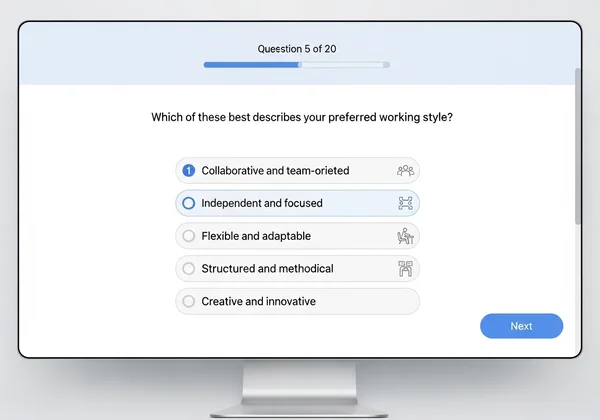RAADS-R Test: A Guide for Newly Identified Autistic Adults on the Spectrum
Welcome. If you are reading this, you are likely standing at the threshold of a profound personal discovery. This journey often brings validation, confusion, and countless questions. This guide is for you—the adult who has recently identified, or is exploring the possibility of being, autistic. It is a compassionate roadmap to understanding what comes next, embracing your neurodivergent identity, and navigating life on the spectrum with newfound clarity.
So, what does life on the spectrum mean for you?
This new understanding can unlock a lifetime of experiences. It provides a framework for self-compassion and new words to describe your inner world. To begin this exploration with structure, you can take the RAADS-R self-assessment online as a first step in self-reflection.

Understanding Your Autistic Identity with RAADS-R Test Insights
The first step after identification is an internal one. You start to reframe your life story through a new lens. This is not about changing who you are. Instead, it is about finally understanding who you have always been.
This period is crucial for embracing neurodivergence as an integral and valid part of your identity. Moreover, it allows you to build confidence and compassion for yourself.
Processing a Late Autism Discovery with Screening Tools
For many, a late autism discovery brings mixed emotions. You might feel relief as past struggles suddenly make sense. At the same time, you may feel grief for missed support, or anger at years of unanswered questions. Allow yourself to feel all of it. This process is not linear. Therefore, be patient and kind to yourself as you integrate this new self-understanding.
What Does "Life on the Spectrum" Mean for You?
"Life on the spectrum" is not one single experience. It is a unique set of strengths, challenges, and perspectives. For you, it might mean deep focus on passions, a strong sense of justice, or the ability to notice patterns others miss. It might also involve challenges with social communication, sensory sensitivity, or executive functioning. Understanding your profile helps you build a life that works with you, not against you. As a result, an initial screening can provide a useful map of these traits, offering a starting point for further self-reflection.
Daily Challenges: Masking, Burnout and Sensory Needs
With self-awareness, you can identify and address challenges that were once invisible. Many newly identified autistic adults find that concepts like masking, burnout, and sensory needs change their daily life from survival to growth.
Unmasking: Expressing Your Authentic Self
Autistic masking means hiding natural traits to fit in.It is an exhausting, long-term performance that can lead to a lost sense of self. Unmasking is the process of letting that performance go. Start small. For example, allow yourself to stim in private, wear comfortable clothing, or communicate directly with trusted friends. Step by step, this brings you back to your authentic self.
How to Recognize and Recover from Autistic Burnout
Have you ever felt so exhausted that skills you once had seemed to vanish? This may be autistic burnout. It's a state of deep exhaustion caused by the constant stress in a world not designed for you. Recovery requires radical rest, fewer demands, and time spent on your special interests. These activities recharge you. Recognizing the signs of burnout is the first step preventing it and honoring your needs.
Managing Sensory Overload Day to Day
The world can be a loud, bright, and overwhelming. A common autistic trait is heightened sensitivity to sensory input. Sensory overload happens when the brain gets more input than it can handle. Learning your triggers and using strategies is life-changing. For example, you can use noise-canceling headphones, wear sunglasses indoors, choose quieter shopping times, or create a calming space at home. If you’d like structured guidance, you can explore your sensory profile with an autism screening inspired by RAADS-R.

Building Connections in the Autistic Community
A late discovery of autism can change your social world. It may explain past struggles and show a new path for building authentic, supportive connections. Finding your people is a powerful, validating experience.
Nurturing Authentic Autistic Friendships and Relationships
Understanding your communication style is key. Many autistic relationships thrive on directness, shared interests, and respect foreach other's needs. By setting clear boundaries and communicating openly, you can create healthier and more sustainable friendships and partnerships. Remember, you are not “bad” at socializing—you simply connect differently.
Finding Your Tribe: Online & Local Autistic Communities
There is incredible power in knowing you are not alone. Connecting with the autistic community can be one of the most affirming steps.
Online spaces like Reddit forums (e.g., r/AutismInWomen, r/autisticadults), hashtags on social media (#ActuallyAutistic), and local support groups offer spaces to share experiences. Hearing your own thoughts echoed by others is deeply healing.
To begin finding supportive spaces, you can explore our resources page, which includes recommended online communities and RAADS-R related tools.

Autistic Strengths and Careers: Thriving at Work
The workplace can be difficult, but it can also highlight autistic strengths. By understanding your profile, you can advocate for your needs and find careers that align with your abilities. Try to turn your neurotype into a professional asset.
Finding Autism-Friendly Jobs and Workplaces
Many autistic individuals excel in roles that require focus, pattern recognition, or attention to detail.. Fields like data analysis, programming, research, or archiving can be excellent fits. The key is finding an environment that values your contributions. Look for jobs with clear expectations, flexible work arrangements, and quiet spaces. These autism-friendly jobs can help you thrive.
Advocating for Workplace Accommodations as an Autistic Adult
You have a right to workplace accommodations that support your success. These are not special privileges but necessary adjustments.
Examples include noise-canceling headphones, written instructions, remote work options, or modified lighting. Learning to ask for these needs can transform your work life from stressful to fulfilling.

Your Next Steps on the Autistic Journey
This discovery is not an ending but a new beginning. It is an invitation to live more authentically, show self-compassion, and build a life that honors who you are. The journey ahead involves continuous learning, connecting with community, and embracing the unique way you experience the world.
Your path is your own, but you don't have to walk it alone. Using tools for self-discovery can give you insights to light the way. If you are ready to take the next step in understanding your personal traits, we invite you to start your RAADS-R test.
Common Questions for Newly Identified Autistic Adults
Can the RAADS-R test be used for self-diagnosis?
No. Online tools are for self-reflection and learning only. They do not replace a clinical diagnosis from a qualified professional. However, they are a good first step before seeking professional support.
What is considered a high score on the RAADS-R test?
A score above a threshold suggests many autism traits. However, a score is just a number. It is more important to notice patterns in your responses and how they connect to your life. The results are a guide for self-exploration, not a definitive label. For a deeper look, you can review your autistic traits with the RAADS-R test.
How should I interpret my RAADS-R test results?
Interpret your results as a map, not a verdict. Look at the breakdown across different domains—like social relatedness, sensory-motor, and circumscribed interests. This can help you identify specific areas of strength and challenge. Use the results as a catalyst for further reading, journaling, and conversations with trusted individuals or professionals. They are a tool to enhance your understanding, not define you.
What is the benefit of the AI personalized report after my screening?
While the initial score provides a quantitative overview, the optional AI personalized report offers a qualitative leap in understanding. By incorporating your answers to additional background questions, the AI generates a nuanced, contextual narrative that connects your scores to your personal life experiences. It provides deeper insights beyond the numbers, helping you see the practical implications of your traits and offering a richer, more personalized foundation for your self-discovery. To gain deeper insights with the AI report, consider exploring this unique feature.